Research
Active Galactic Nuclei (AGN) are one of the most important source classes in high energy astrophysics. AGNs form a large class of sources, of which in particular blazars are most important. AGNs are first on the one hand a compact region in the center of a galaxy, which has a significantly increased luminosity over large parts of the electromagnetic spectrum. These compact regions have three constituent elements: a supermassive black hole, around which an accretion disk is formed, and a plasma emission perpendicular to it, the jet.
Leptonic Models
|
The first modeling of AGN with leptonic models was undertaken with the SED code. Here, a given spectrum of electron energy is injected into a homogeneous radiation zone. Various radiation processes (synchrotron radiation, ynchrotron self-absorption, inverse Compton scattering) take place there. The equations for electron and photon distribution are solved as a function of time. A time-dependent SSC model is effectively implemented. This code was e.g. used for modeling 1ES1218 + 30.4 (Spectral modelling of 1 ES 1218+30.4 (Rüger, Spanier, and Mannheim 2010 Monthly Notices of the Royal Astronomical Society )) This model enables not only the modeling of static spectra, but also, to a certain extent, the modeling of the variability. While the radiation processes - and the associated development of the particle distribution - are represented in a self-consistent manner, variability is only due to external factors (e.g. a sudden change in the injected particle spectrum). |
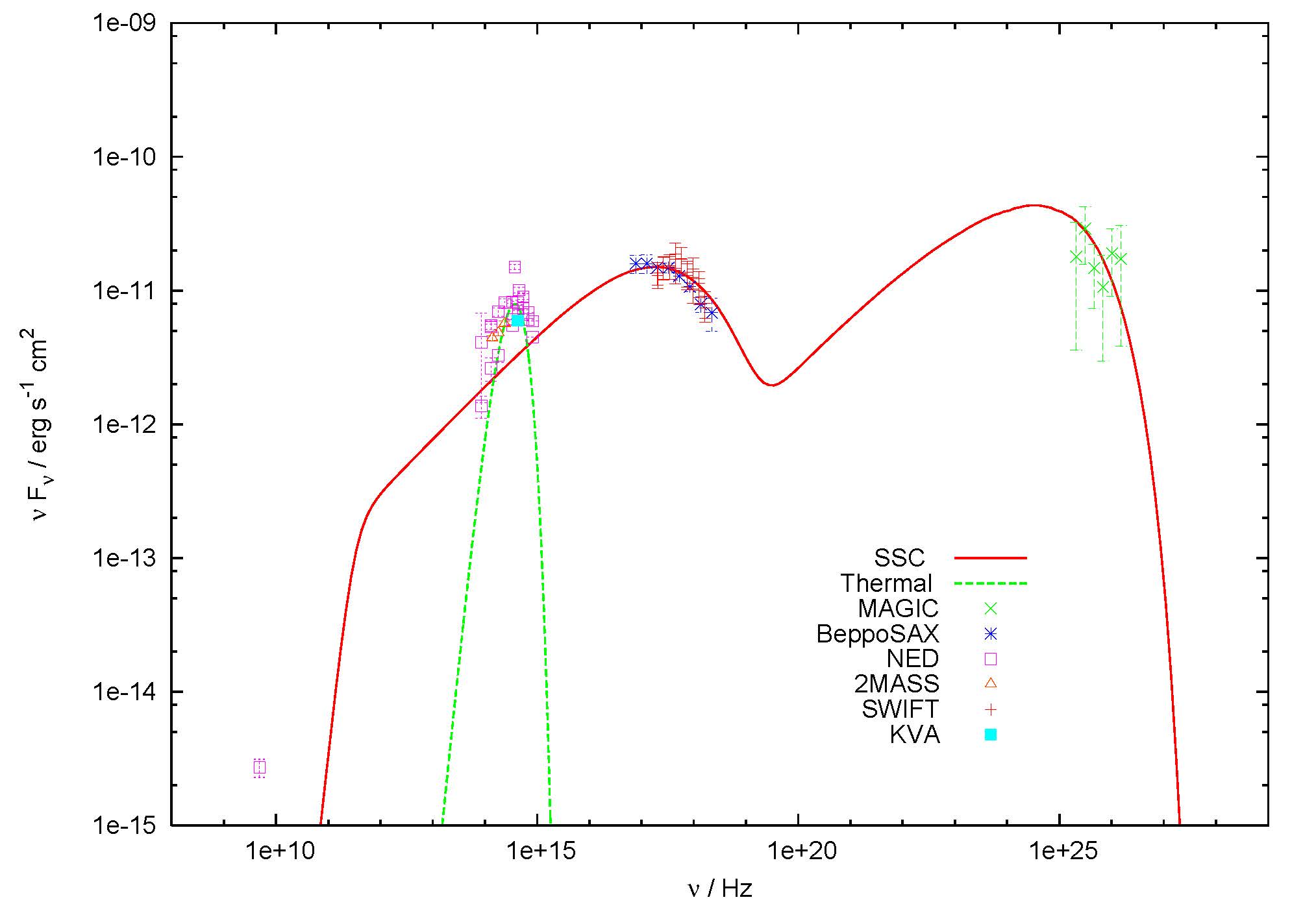 Model of 1ES1218+30.4 using the SED code. Source: (Spectral modelling of 1 ES 1218+30.4 (Rüger, Spanier, and Mannheim 2010 Monthly Notices of the Royal Astronomical Society)) |
|
The COJONES code was developed to model the particle spectrum self-consistently. It differs from the SED code essentially in that, instead of a single homogeneous radiation zone, it contains an acceleration zone and a radiation zone. In the acceleration zone, the kinetic equation of the electrons is solved, whereby Fermi-I and -II acceleration are taken into account. This enables acceleration and radiation to be simulated simultaneously and in a self-consistent manner. A typical scenario here is the modeling of variability by changing the injection of primary particles. Since these are then also accelerated, a different - and more complex - pattern results than with the simple SED model. A first application is the source 1ES 1218 + 30.4 ( Modeling the variability of 1ES1218 + 30.4 (Weidinger and Spanier 2010 Astronomy and Astrophysics) ) This source was already modeled with SED, but the aim here was to show that more recent observations with VERITAS are still compatible with a leptonic model. The time-dependent solution of the kinetic equations makes it possible to model the variability in a self-consistent manner. Here in the picture on the right you can ultimately see the response function of the system to a step-like change in the injected density. It can be seen that the rise and fall of the light curve are not symmetrical to one another (the rise is determined by the time scales of the acceleration, the fall by the cooling time scales). Furthermore, the light curves in the various bands are also significantly different from one another. |
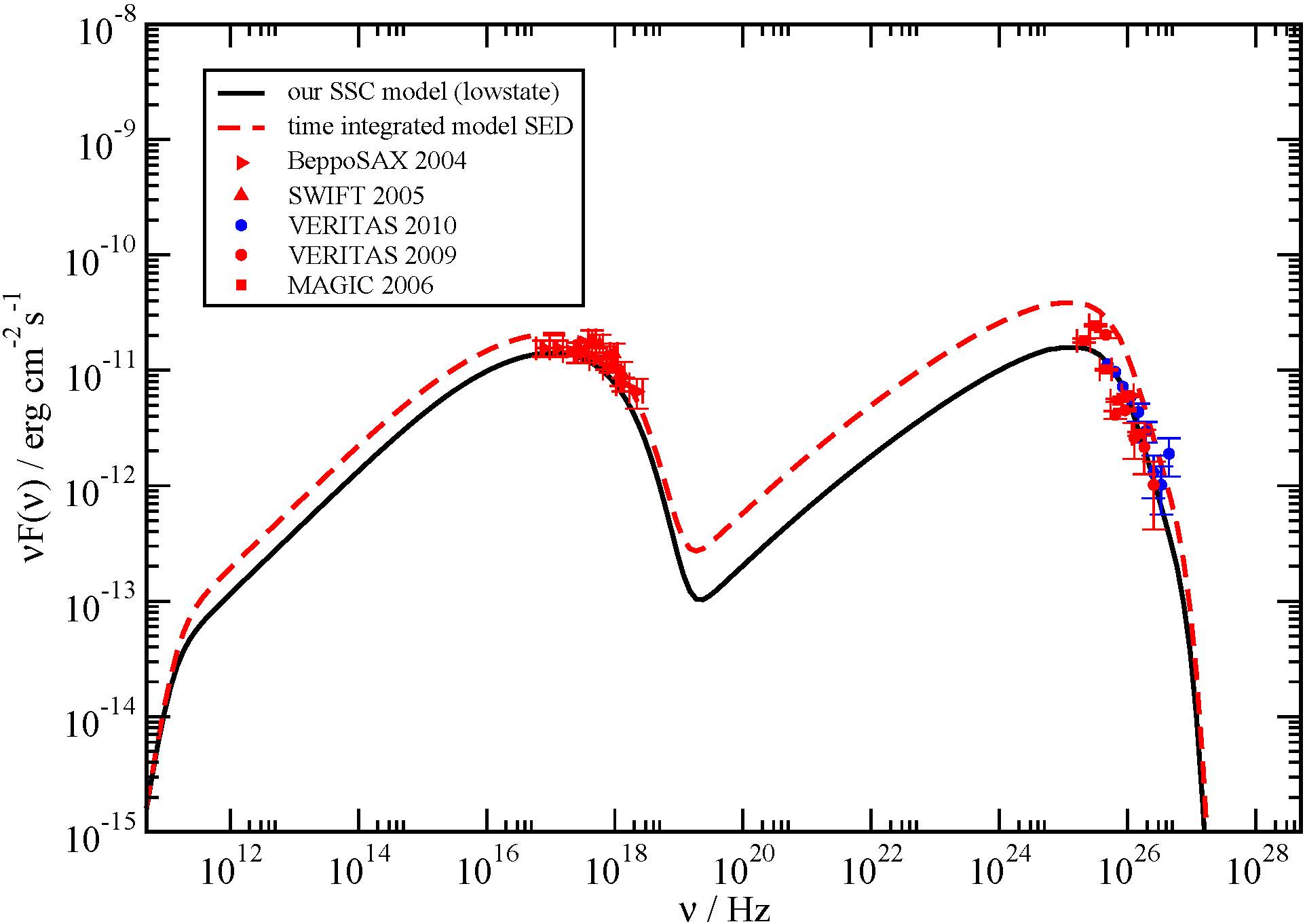 Model of 1ES1218+30.4 in low flux state using the COJONES code. Source: Modelling the variability of 1ES1218+30.4 (Weidinger and Spanier 2010 Astronomy and Astrophysics ) 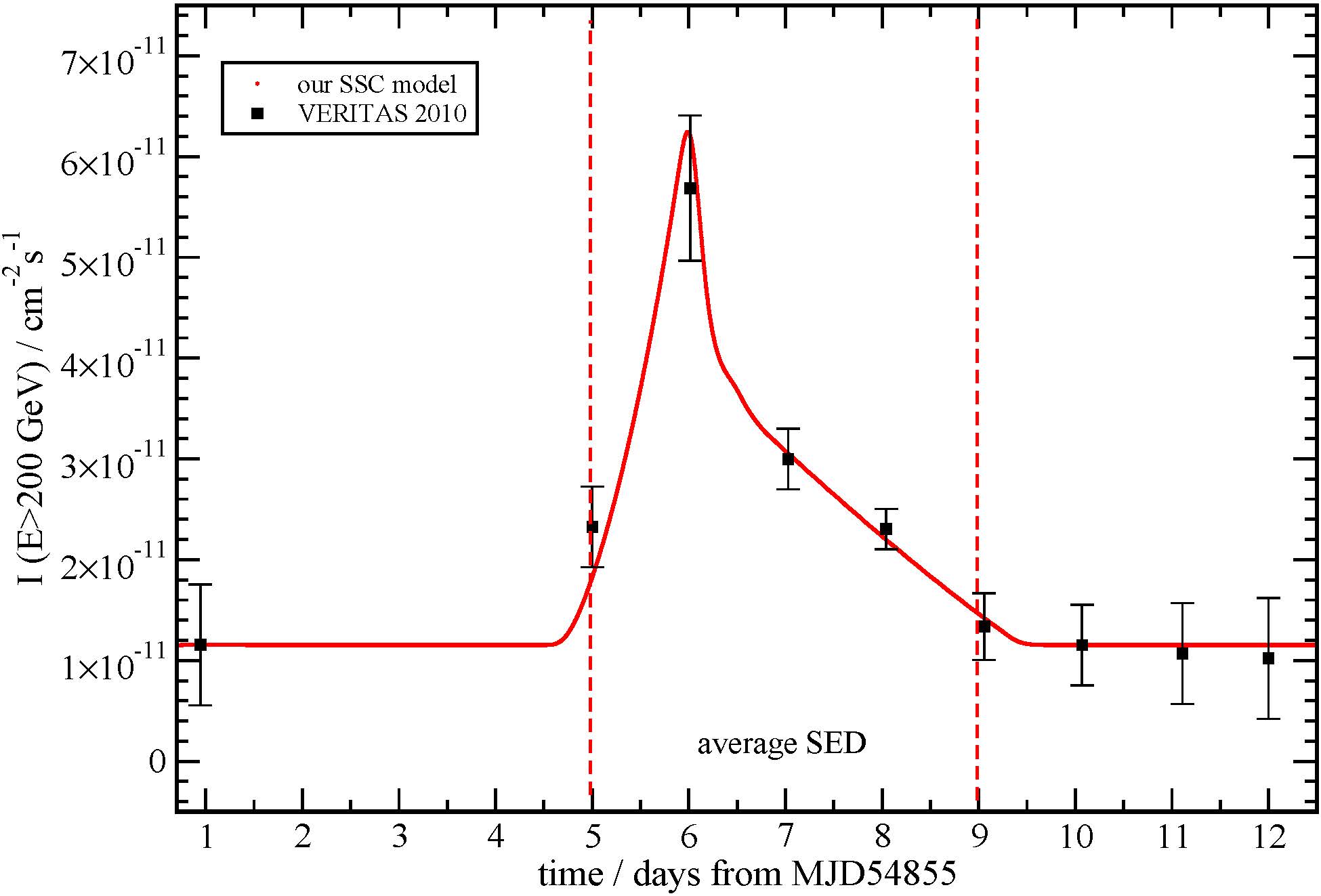 Light curve of 1ES1218+30.4 using the COJONES code. Source: Modelling the variability of 1ES1218+30.4 (Weidinger and Spanier 2010 Astronomy and Astrophysics ) |
|
The COJONES model was also used for significantly more complex variability patterns, e.g. the extreme short-term variability of PKS 2155-30.4 With this source, a complex variability pattern in the minute range was measured. In Modeling the steady state spectral energy distribution of the BL-Lac Object PKS 2155-30.4 using a self-consistent SSC model (Weidinger, Rüger, and Spanier 2010 Astrophysics and Space Sciences Transactions) this pattern could be reproduced (see figure on the right). While the acceleration and radiation model is inherently consistent, the external change in density cannot be explained in the model. Whether a change in the external density is actually responsible for the variability can be determined by means of multiband analyzes, since the behavior in other frequencies should show characteristic changes. |
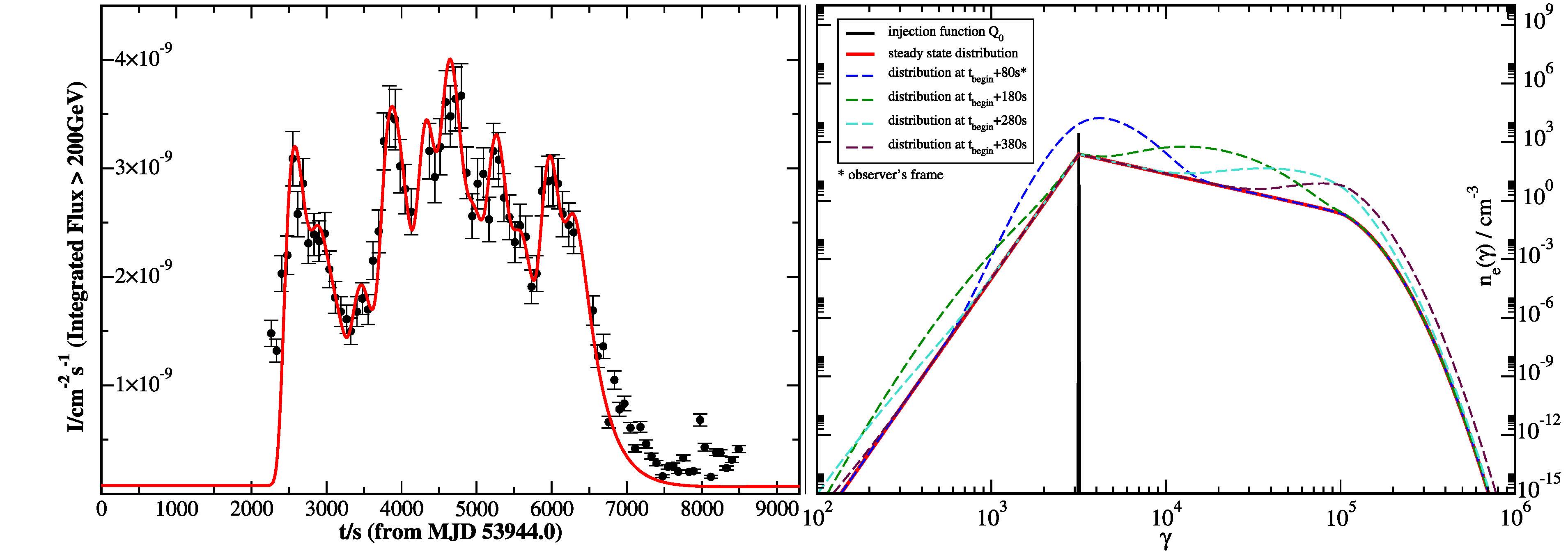 Model of the extreme short-time variability of PKS 2155 using the COJONES Code. Quelle: Modelling the steady state spectral energy distribution of the BL-Lac Object PKS 2155-30.4 using a selfconsistent SSC model (Weidinger, Rüger, and Spanier 2010 Astrophysics and Space Sciences Transactions ) |
Hadronic models
|
In many AGNs, not only electrons but also protons are accelerated to non-thermal energies. These protons can then also contribute to the radiation. In the simplest case, the contribution of the protons is only synchrotron radiation from the protons (the high magnetic fields required for this are usually present, since high magnetic fields are also necessary to keep the protons in the source). However, proton-proton or proton-photon collisions can also produce secondary particles that contribute to the radiation. In most AGN the matter density is far too low for the p-p processes to play a role. p-γ-processes, however, are often relevant. This creates neutral pions π0, which in turn decay while emitting two photons, and charged pions π±, ultimately decay into electrons and positrons. These particles can emit synchrotron radiation at any time. The final electrons and positrons can in turn play a role through pair creation and annihilation. The determination of the scattering cross-sections plays an important role. A mathematically easy-to-use method was found in Simplified Models for Photohadronic Interactions in Cosmic Accelerators (Hümmer, Rüger, Spanier, and Winter 2010 The Astrophysical Journal) . The most important aspect is that double integrals over proton AND photon distribution could be avoided here. |
 Parametrisation of the photo-hadronic cross-section using the Hümmer et al. model. Source: Simplified Models for Photohadronic Interactions in Cosmic Accelerators (Hümmer, Rüger, Spanier, and Winter 2010 The Astrophysical Journal ) |
|
The parameterization of the scattering cross-sections mentioned above was also used in COJONES to model hadronic sources. In addition, protons are injected into the model system, which are accelerated just like the electrons (the acceleration time for the protons alone is smaller by the squared mass factor). In addition to the leptonic processes, proton synchrotron, π0 decay, electron / positron generation from π± and pair generation / annihilation are implemented. A typical application is described in A self-consistent and time-dependent hybrid blazar emission model. Properties and application (Weidinger and Spanier 2015 Astronomy and Astrophysics) (pictures on the right). The spectral energy distribution shows slight differences here with 1ES1011 - the high energy range is essentially flatter than the synchrotron peak. The 1ES1011 source is, however, a source at the transition area between HBL and LBL sources. For Flat Spectrum Radio Quasars it is expected that the influence of the protons will be stronger. A clearly different picture emerges when looking at light curves: In leptonic models, the light curves in individual bands do not differ very clearly, more typically the shape is similar, but there is usually a time shift. Here you can see, however, that very different shapes and even so-called orphan flares can arise, i.e. strong increases in flow in one energy band that do not occur in other bands. This can be explained by the fact that the time scales and emission processes decouple electrons and protons. While the electrons are accelerated quickly and radiate just as quickly when particles are injected, the protons need a very long time to reach relevant energies. Since the electrons and positrons from p-γ collisions are relevant here in this special case, they also cascade from high energies down to low energies. From a mere consideration of the spectral energy distribution, it is usually not possible to distinguish directly between leptonic and hadronic radiation processes. The light curves, on the other hand, speak a clearer language. |
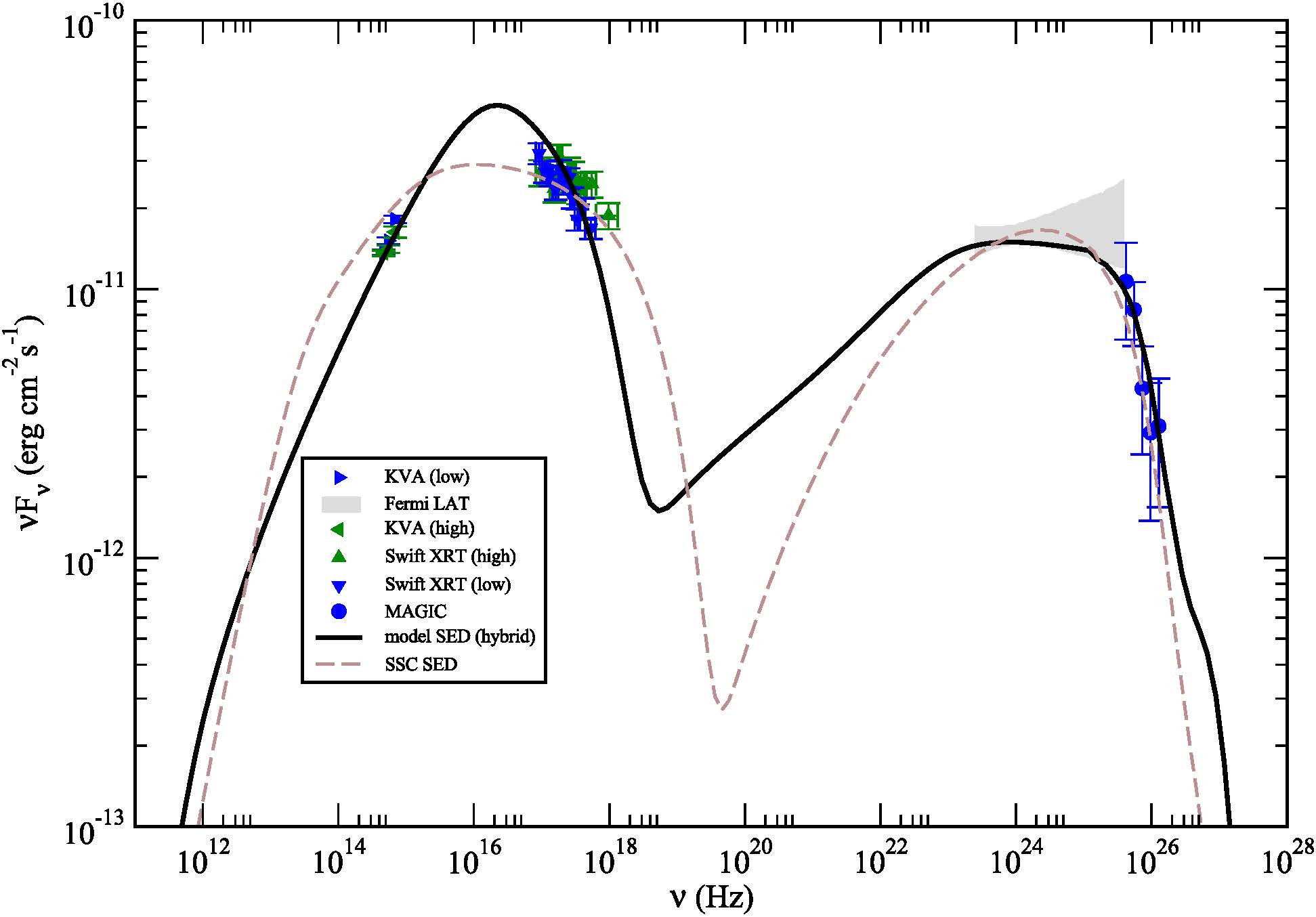 Model of 1ES1011 using the hadronic COJONES code. Source: A self-consistent and time-dependent hybrid blazar emission model. Properties and application (Weidinger and Spanier 2015 Astronomy and Astrophysics ) 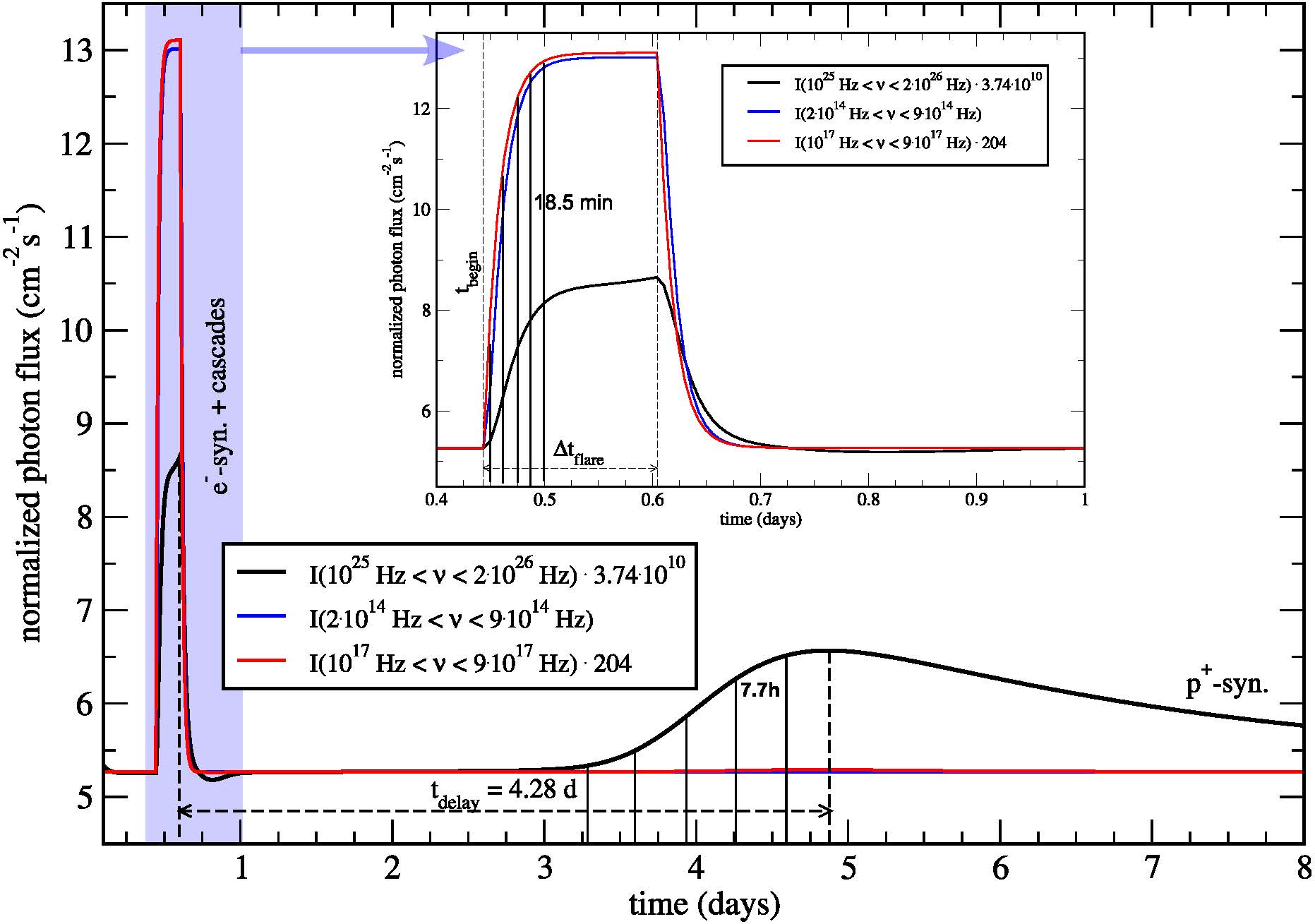 Light curve of 1ES1011 using the hadronic COJONES code. Source: A self-consistent and time-dependent hybrid blazar emission model. Properties and application (Weidinger and Spanier 2015 Astronomy and Astrophysics ) |
|
From the UNICORN code described below, UNICORN-0D was developed as the successor to COJONES. In addition to numerous technical innovations (CUDA support, MPI parallelization, HDF5 output), physical processes such as the synchrotron radiation of unstable particles were integrated. Due to the high speed of UNICORN-0D it was in AGN neutrino flux estimates for a realistic hybrid model (Richter and Spanier 2018, Astroparticle Physics) possible to carry out a series investigation: For a set of model sources it was investigated how many neutrinos could be detected from such a source with IceCUBE. The magnetic field and the injection rates of electrons and protons were varied over a wide range. It turns out that a simple connection between gamma observations and neutrino detection is not possible. The estimate "one photon = one neutrino" is therefore not tenable. |
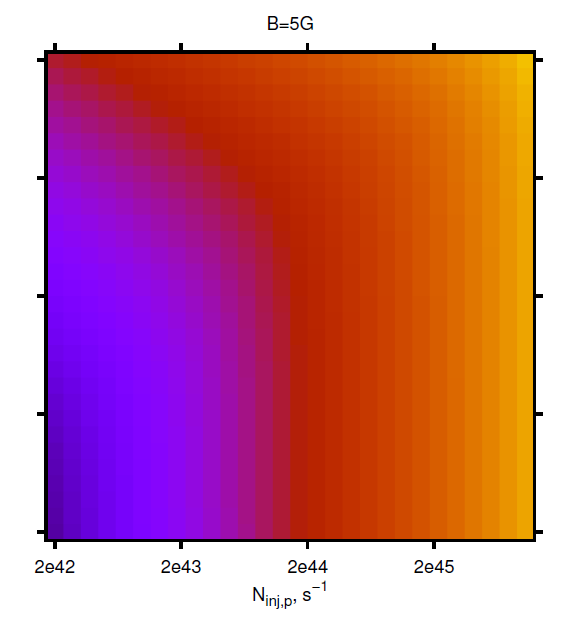 Simulated IceCUBE detection rate. Source: AGN neutrino flux estimates for a realistic hybrid model (Richter und Spanier 2018, Astroparticle Physics) |
Spatially resolved models
|
A further development of AGN modeling is spatially resolved modeling with the UNICORN code: Here the simulation area is divided in the jet direction. The particle acceleration is represented by particle scattering on an artificial fluid shock. One application is the long-wave radio emission from AGN. Previous AGN models were not able to hit the data at very low frequencies. The paradigm for this has been "The radiation is generated by cooled electrons". With UNICORN there was an opportunity to test this paradigm. In A Numerical Model of Parsec-scale SSC Morphologies and Their Radio Emission (Richter and Spanier 2016 The Astrophysical Journal) shows that the electron cooling in a cylindrical jet would not be efficient enough. In fact, it can be shown from the measurement data that the correct radio data can only be obtained assuming a logarithmic jet profile. The picture on the right shows the one for Markarian 501. |
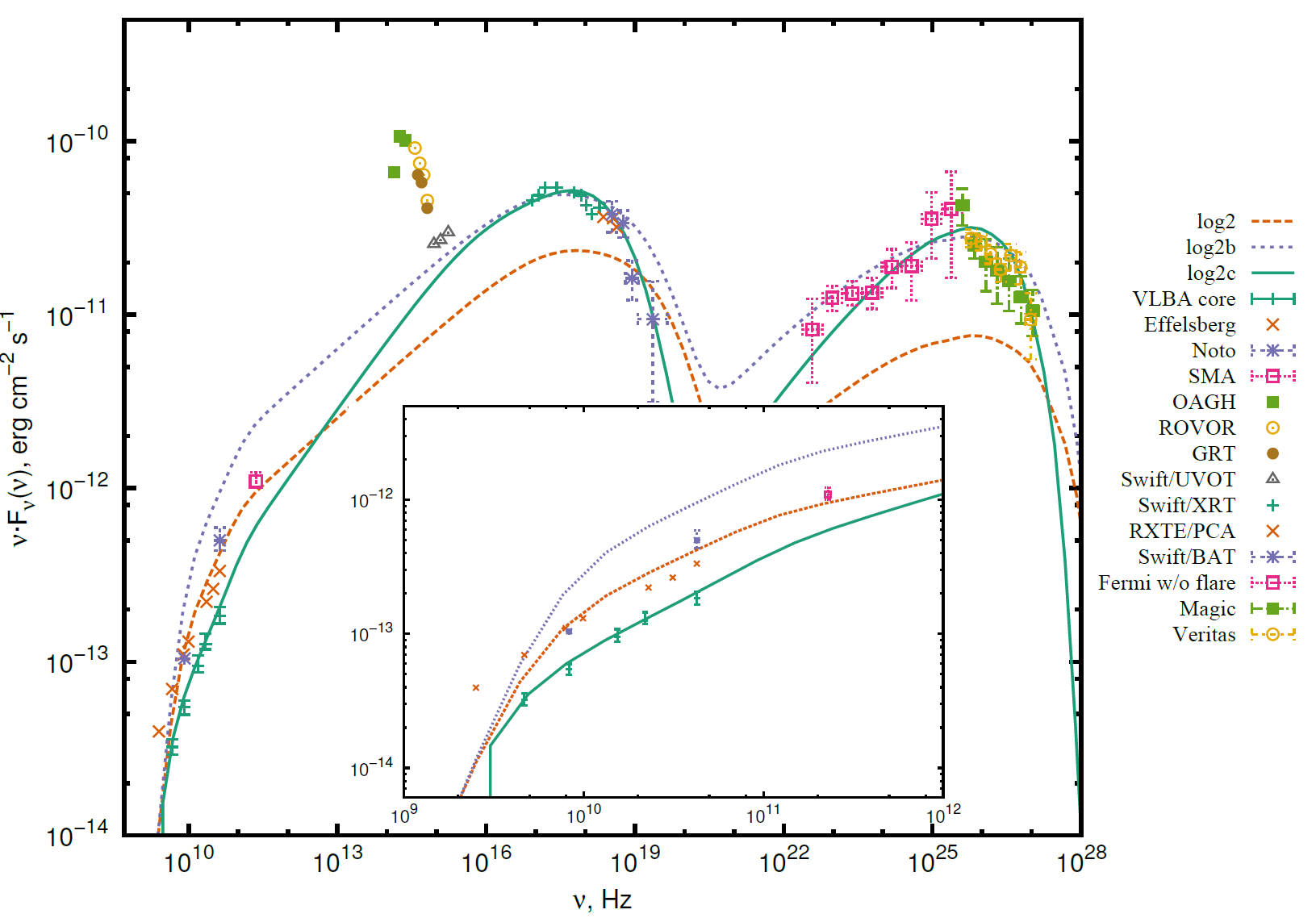 SED of Mrk 501 for different jet forms. Only for a logarithmic shape the model data and the observational data conincide. Source: A Numerical Model of Parsec-scale SSC Morphologies and Their Radio Emission (Richter and Spanier 2016 The Astrophysical Journal ) |
|
Another problem can be tackled with spatially resolved models: For variability scenarios it is usually assumed that some variable changes. Where this change comes from is not specified. With UNICORN it is now possible to test a specific physical model: multiple shocks. In Multi-band implications of external-IC flares (Richter and Spanier 2015 Astroparticle Physics ) it was compared how light curves differ for different scenarios. In fact, for a certain set of observations, it was shown that only multiple shocks can explain the light curves. |
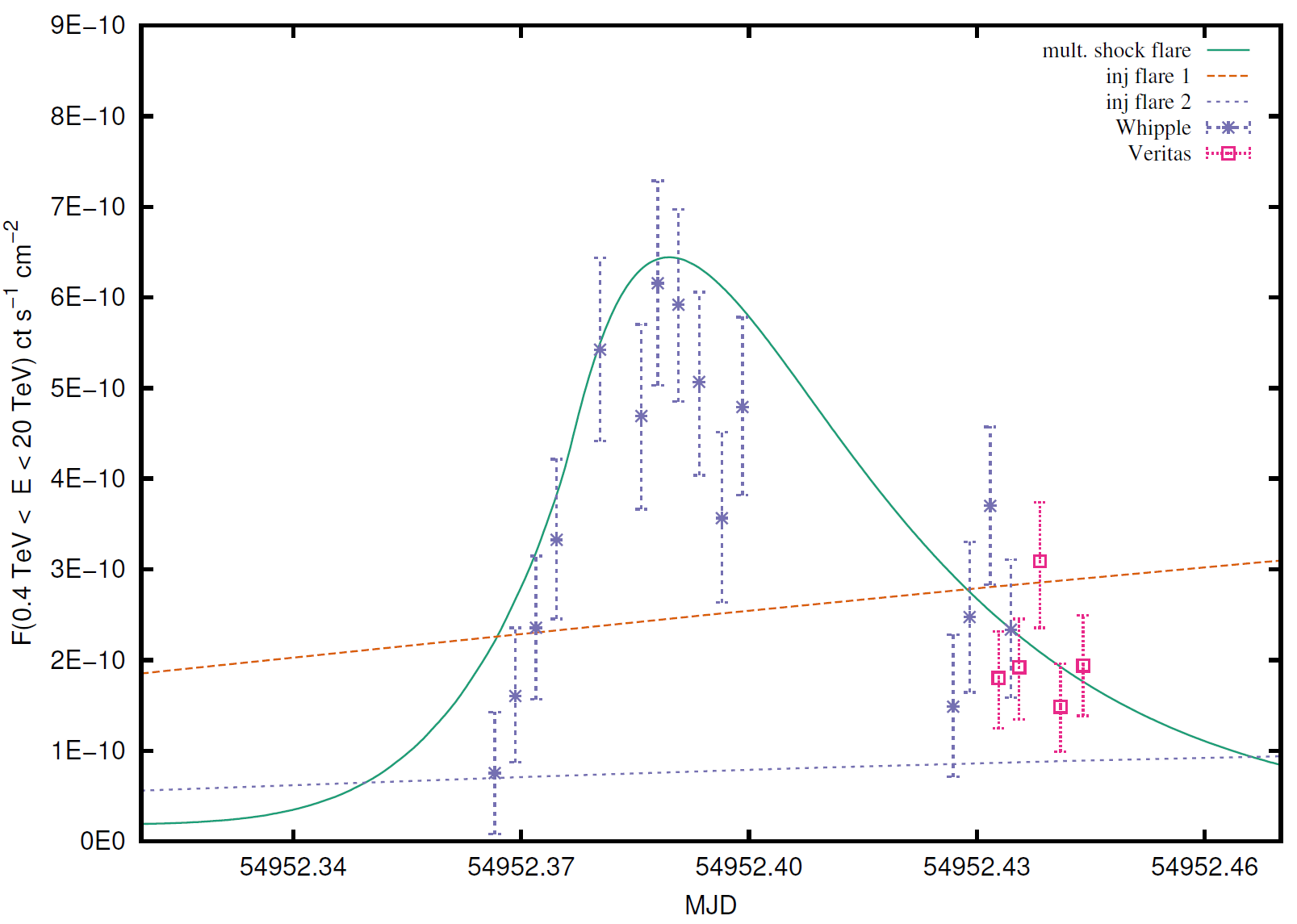 Light curves for different variability scenarios including the observational data. Source: Multi-band implications of external-IC flares (Richter and Spanier 2015 Astroparticle Physics ) |

 Home page
Home page